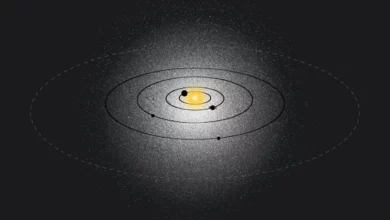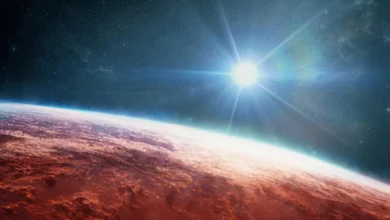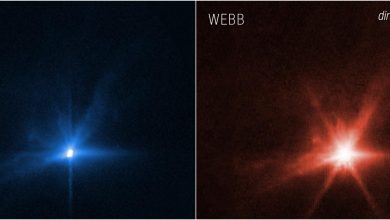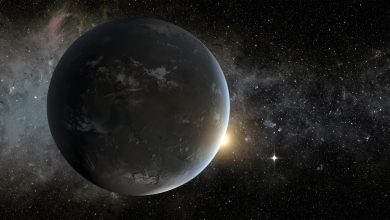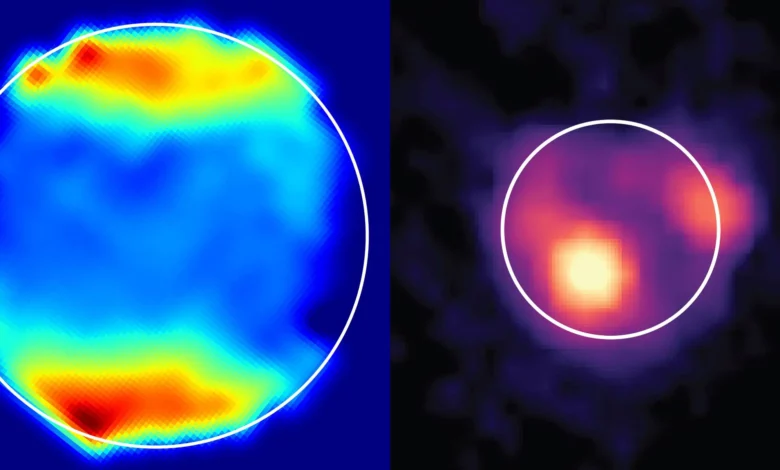
Lead Image: New discoveries by the James Webb Space Telescope have unveiled secrets about Jupiter’s largest moon, Ganymede, and the most volcanically active one, Io. The findings include evidence of the peroxide being produced by charged particles impacting the ice on Ganymede, and new observations of ongoing eruptions on Io. Credit: Ganymede: Samantha Trumbo, Cornell; Io: Imke de Pater, UC Berkeley
Groundbreaking observations by the James Webb Space Telescope have revealed hydrogen peroxide on Ganymede and ongoing volcanic eruptions on Io, enhancing our understanding of Jupiter’s moons and the broader solar system.
With its sensitive infrared cameras and high-resolution spectrometer, the James Webb Space Telescope (JWST) is revealing new secrets of Jupiter’s Galilean satellites, in particular Ganymede, the largest moon, and Io, the most volcanically active.
In two separate publications, astronomers who are part of JWST’s Early Release Science program report the first detection of hydrogen peroxide on Ganymede and sulfurous fumes on Io, both the result of Jupiter’s domineering influence.
“This shows that we can do incredible science with the James Webb Space Telescope on solar system objects, even if the object is really very bright, like Jupiter, but also when you look at very faint things next to Jupiter,” said Imke de Pater, professor emerita of astronomy and earth and planetary science at the University of California, Berkeley. De Pater and Thierry Fouchet from the Paris Observatory are co-principal investigators for the Early Release Science solar system observation team, one of 13 teams given early access to the telescope.
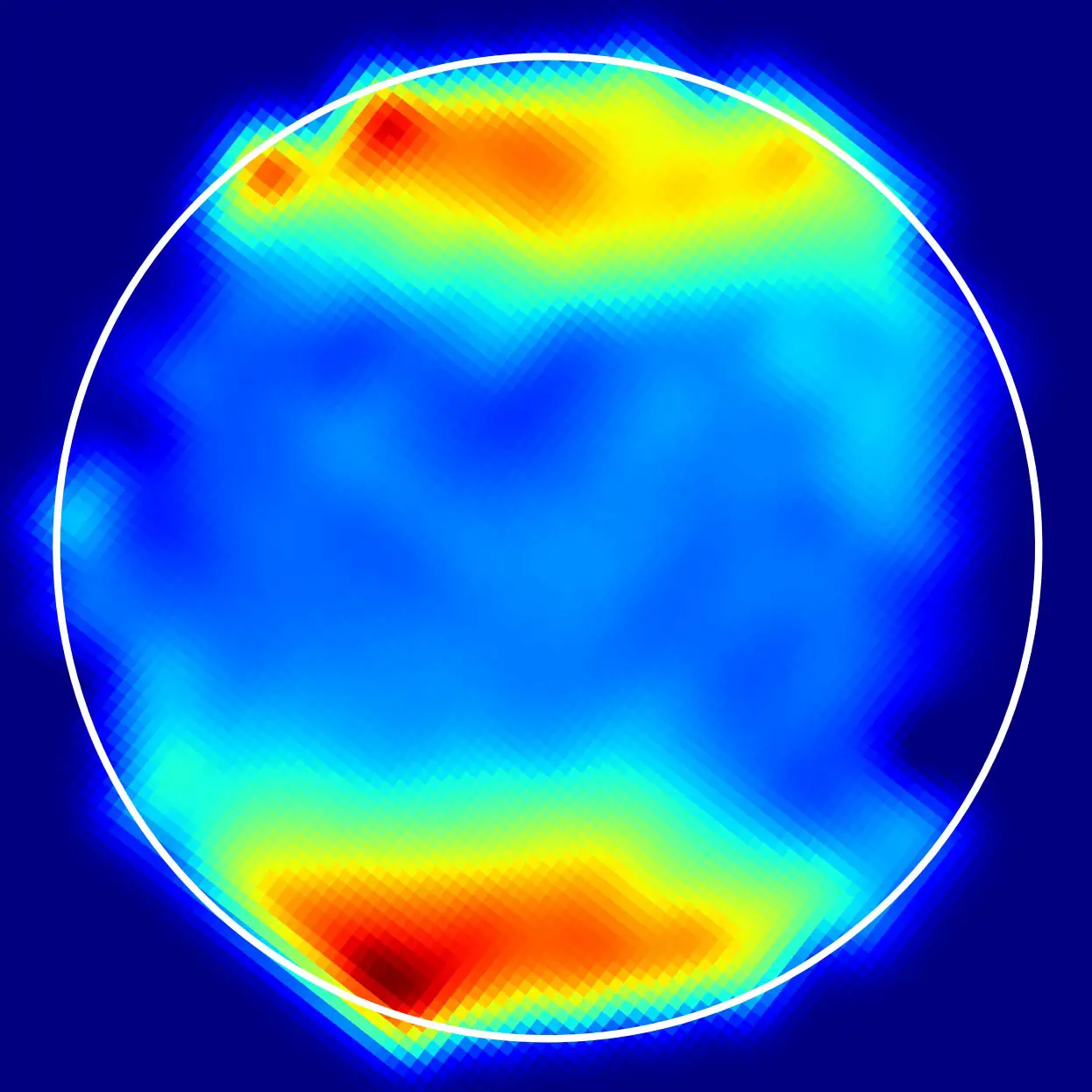
Ganymede’s Hydrogen Peroxide Study
Samantha Trumbo, a 51 Pegasi b postdoctoral fellow at Cornell University, led the study of Ganymede, which was published on July 21 in the journal Science Advances. Using measurements captured by the near infrared spectrometer (NIRSpec) on JWST, the team detected the absorption of light by hydrogen peroxide — H2O2 — around the north and south poles of the moon, a result of charged particles around Jupiter and Ganymede impacting the ice that blankets the moon.
“JWST revealing the presence of hydrogen peroxide at Ganymede’s poles shows for the first time that charged particles funneled along Ganymede’s magnetic field are preferentially altering the surface chemistry of its polar caps,” Trumbo said.
The astronomers argue that the peroxide is produced by charged particles hitting the frozen water ice around the poles and breaking the water molecules into fragments — a process called radiolysis — which then recombine to form H2O2. They suspected that radiolysis would occur primarily around the poles on Ganymede because, unlike all other moons in our solar system, it has a magnetic field that directs charged particles toward the poles.
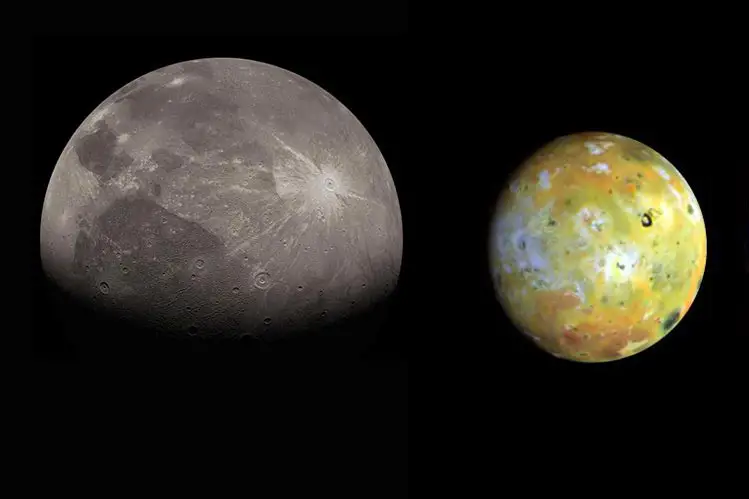
Magnetic Field and Comparison with Europa
“Just like how Earth’s magnetic field directs charged particles from the sun to the highest latitudes, causing the aurora, Ganymede’s magnetic field does the same thing to charged particles from Jupiter’s magnetosphere,” she added. “Not only do these particles result in aurorae at Ganymede, as well, but they also impact the icy surface.”
Trumbo and Michael Brown, professor of planetary astronomy at Caltech, where Trumbo recently received her Ph.D., had earlier studied hydrogen peroxide on Europa, another of Jupiter’s four Galilean satellites. On Europa, however, the peroxide was detectable over much of the surface, perhaps, in part, because it has no magnetic field to protect the surface from the fast-moving particles zipping around Jupiter.
Implications for Outer Solar System
“This is likely a really important and widespread process,” Trumbo said. “These observations of Ganymede provide a key window to understand how such water radiolysis might drive chemistry on icy bodies throughout the outer solar system, including on neighboring Europa and Callisto (the fourth Galilean moon).”
“It helps to actually understand how this so-called radiolysis works and that, indeed, it works as people expected, based on lab experiments on Earth,” de Pater said.
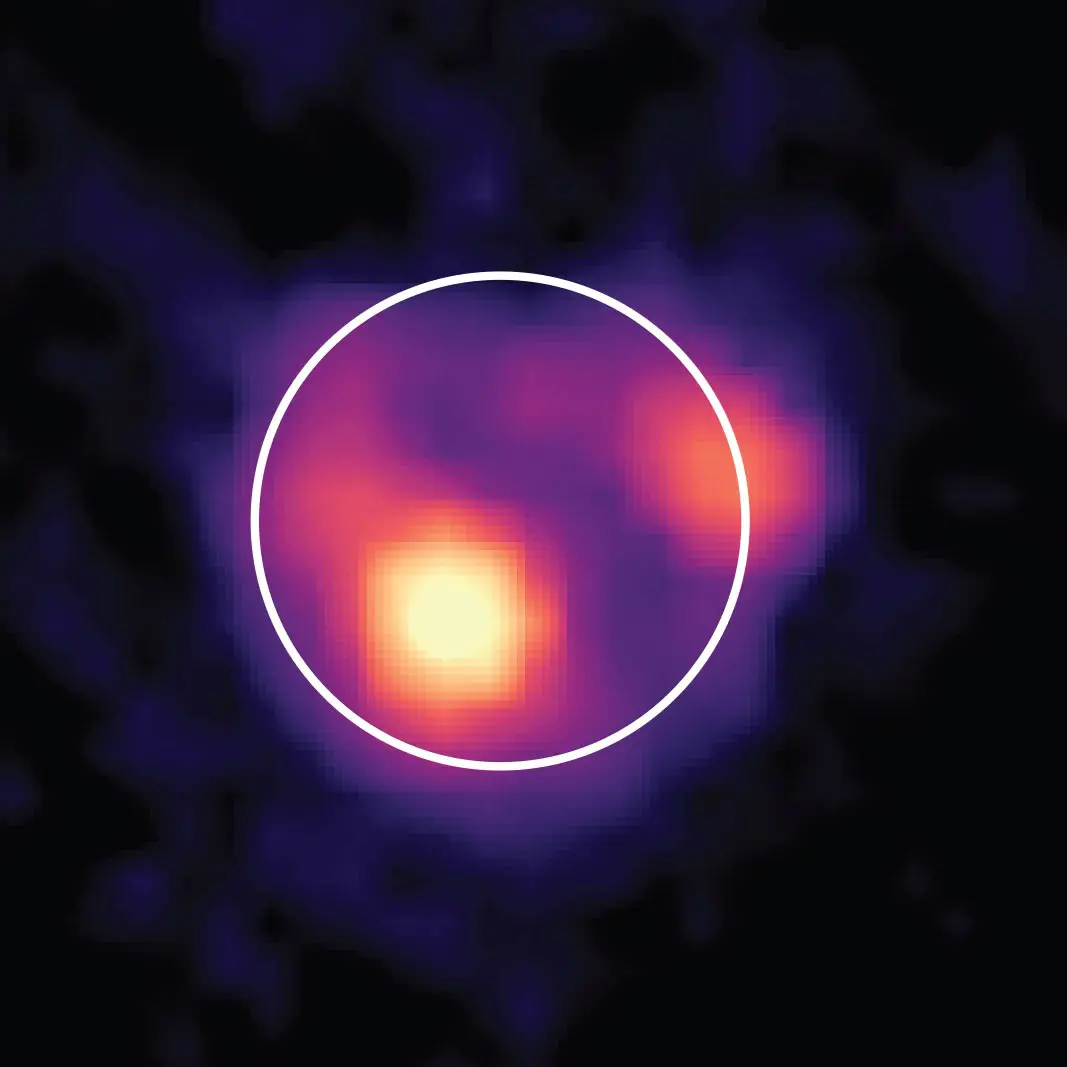
Io’s Sulfurous Environment
In a second paper, accepted for publication in the journal JGR: Planets, a publication of the American Geophysical Union, de Pater and her colleagues report new Webb observations of Io that show several ongoing eruptions, including a brightening at a volcanic complex called Loki Patera and an exceptionally bright eruption at Kanehekili Fluctus. Because Io is the only volcanically active moon in the solar system — Jupiter’s gravitational push and pull heats it up — studies like this give planetary scientists a different perspective than can be obtained by studying volcanos on Earth.
For the first time, the researchers were able to link a volcanic eruption — at Kanehekili Fluctus — to a specific emission line, a so-called “forbidden” line, of the gas sulfur monoxide (SO).
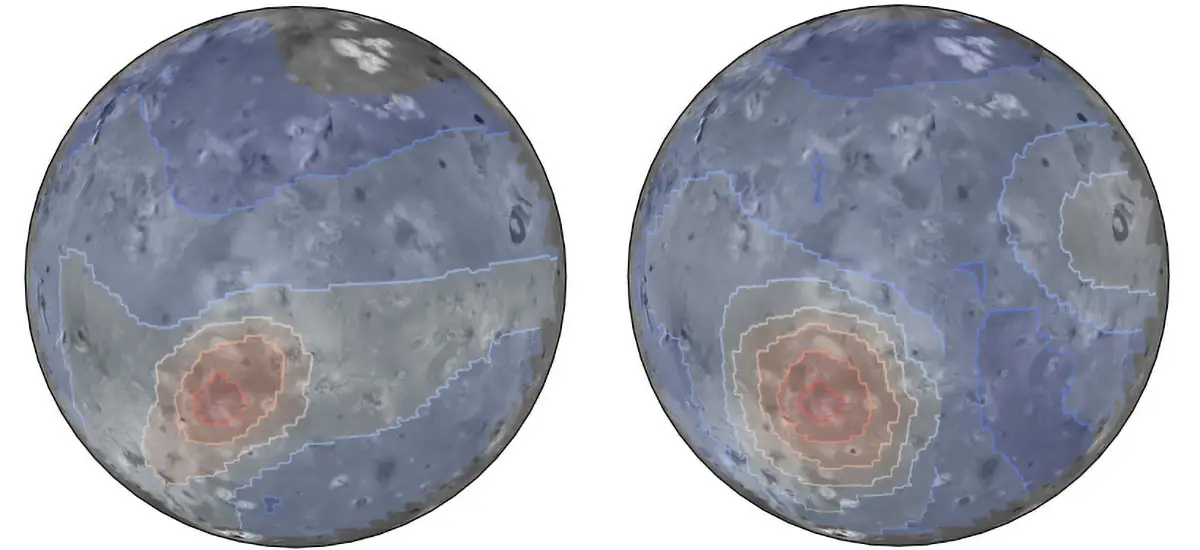
Understanding Io’s Atmosphere
Sulfur dioxide (SO2) is the main component of Io’s atmosphere, coming from sublimation of SO2 ice, as well as ongoing volcanic eruptions, similar to the production of SO2 by volcanos on Earth. The volcanos also produce SO, which is much harder to detect than SO2. In particular, the forbidden SO emission line is very weak because SO is in such low concentrations and produced for only a short time after being excited. Moreover, the observations can only be made when Io is in Jupiter’s shadow, when it is easier to see the glowing SO gases. When Io is in Jupiter’s shadow, the SO2 gas in Io’s atmosphere freezes out onto its surface, leaving only SO and newly emitted volcanic SO2 gas in the atmosphere.
Connection between SO and Volcanoes
“These observations with Webb show for the first time that the SO actually did come from a volcano,” de Pater said.
De Pater had made previous observations of Io with the Keck Telescope in Hawaii and found low levels of the forbidden SO emission over much of the moon, but she was unable to tie SO hotspots specifically to an active volcano. She suspects that much of this SO, as well as the SO2 seen during an eclipse, is coming from so-called stealth volcanoes, which erupt gas but not dust, which would make them visible.
Twenty years ago, de Pater and her team proposed that this excited state of SO could only be produced in hot volcanic vents, and that the tenuous atmosphere allowed this state to stick around long enough — a few seconds — to emit the forbidden line. Normally, excited states that produce this emission are quickly damped out by collisions with other molecules in the atmosphere and never seen. Only in parts of the atmosphere where the gas is sparse do such excited states last long enough to emit forbidden lines. The greens and reds of Earth’s auroras are produced by forbidden transitions of oxygen in the tenuous upper atmosphere.
Further Observations and Concluding Remarks
“The link between SO and volcanoes ties in with a hypothesis we had in 2002 to explain how we could see SO emission at all,” she said. “The only way we could explain this emission is if the SO is excited in the volcanic vent at a temperature of 1500 Kelvin or so, and that it comes out in this excited state, loses its photon within a few seconds, and that is the emission we see. So these observations are the first that actually show that this is the most likely mechanism of why we see that SO.”
Webb will observe Io again in August with NIRSpec. The upcoming observation and the earlier one, which took place on Nov. 15, 2022, were taken when Io was in the shadow of Jupiter so that light reflected from the planet did not overwhelm the light coming from Io.
De Pater noted, too, that the brightening of Loki Patera was consistent with the observed period of eruptions at the volcano, which brighten, on average, about every 500 Earth days, with the brightening lasting for a couple of months. She determined this because it was not bright when she observed the moon with Keck in August and September 2022, nor was it bright when another astronomer observed it from April through July 2022. Only the JWST captured the event.
“The Webb observations showed that actually eruptions had started, and that it was much brighter than what we had seen in September,” she said.
While De Pater is primarily focused on the Jovian system — its rings, small moons and the larger moons Ganymede and Io — she and other members of the early science team of some 80 astronomers are also using JWST to study the planetary systems of Saturn, Uranus and Neptune.
References:
“Hydrogen peroxide at the poles of Ganymede” by Samantha K. Trumbo, Michael E. Brown, Dominique Bockelée-Morvan, Imke de Pater, Thierry Fouchet, Michael H. Wong, Stéphanie Cazaux, Leigh N. Fletcher, Katherine de Kleer, Emmanuel Lellouch, Alessandro Mura, Olivier Poch, Eric Quirico, Pablo Rodriguez-Ovalle, Mark R. Showalter, Matthew S. Tiscareno and Federico Tosi, 21 July 2023, Science Advances.
DOI: 10.1126/sciadv.adg3724
“An Energetic Eruption With Associated SO 1.707 Micron Emissions at Io’s Kanehekili Fluctus and a Brightening Event at Loki Patera Observed by JWST” by Imke de Pater, Emmanuel Lellouch, Darrell F. Strobel, Katherine de Kleer, Thierry Fouchet, Michael H. Wong, Bryan J. Holler, John Stansberry, Patrick M. Fry, Michael E. Brown, Dominique Bockelée-Morvan, Samantha K. Trumbo, L. N. Fletcher, Matthew M. Hedman, Edward M. Molter, Mark Showalter, Matthew S. Tiscareno, Stéphanie Cazaux, Ricardo Hueso, Statia Luszcz-Cook, Henrik Melin, Chris Moeckel, Alessandro Mura, Glenn Orton, Lorenz Roth, Joachim Saur, Federico Tosi, 18 July 2023, JGR: Planets.
DOI: 10.1029/2023JE007872

